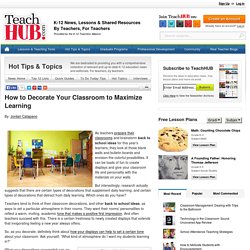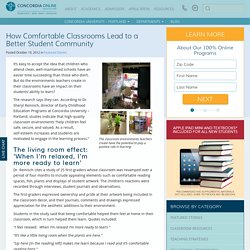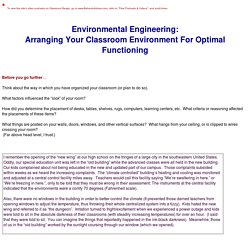

What do the best classrooms in the world look like? Imagine if we designed the 21st-century American classroom to be a place where our kids could learn to think, calculate, and invent as well as the students in the top-performing countries around the world.

What would those spaces look like? Would students plug into mini-MRI machines to record the real-time development of their brains' executive functions? Would teachers be Nobel Prize winners, broadcasting through screens installed in the foreheads of robots that don't have tenure? To find out, we don't have to travel through time. We could just travel through space. Classrooms in countries with the highest-performing students contain very little tech wizardry, generally speaking. But the most innovative schools around the world do not tend to be the ones with the most innovative technology inside them. In her Korean school, near Seoul, her classmates have iPod touches and iPhones and play Nintendo, just like her classmates in America. School does not have to be grueling to be good. What Does Your Body Language Say About You? How To Read Signs and Recognize Gestures - Jinxi Boo - Jinxi Boo.
Art by LaetitziaAs we all know, communication is essential in society.

Advancements in technology have transformed the way that we correspond with others in the modern world. Because of the constant buzz in our technological world, it's easy to forget how important communicating face-to-face is. When conversing old-school style, it's not only speech we verbalize that matters, but what our nonverbal gestures articulate as well. Body language is truly a language of its own. We all have quirks and habits that are uniquely our own. 10% from what the person actually says40% from the tone and speed of voice50% is from their body language. Lowering one's head can signal a lack of confidence.
Pushing back one's shoulders can demonstrate power and courageOpen arms means one is comfortable with being approached and willing to talk/communicate. How to Decorate Your Classroom to Maximize Learning. As teachers prepare their classrooms and brainstorm back to school ideas for this year’s learners, they look at those blank walls and bulletin boards and envision the colorful possibilities.

It can be loads of fun to create displays and give your classroom life and personality with the materials on your walls. But interestingly, research actually suggests that there are certain types of decorations that supplement daily learning, and certain types of decorations that detract from daily learning. Which ones do you have? Teachers tend to think of their classroom decorations, and other back to school ideas, as ways to set a particular atmosphere in their rooms. Positive Classroom Environment through Classroom Design. The classroom environments teachers create have the potential to play a positive role in learning.

It’s easy to accept the idea that children who attend clean, well-maintained schools have an easier time succeeding than those who don’t. But do the environments teachers create in their classrooms have an impact on their students’ ability to learn? The research says they can. According to Dr. Are decorated classroom walls too distracting? Room Setup - The School Supply Addict. Well-designed classrooms can boost learning progress in primary school pupils by16%, new research reveals.
Tuesday 24 February 2015 For the first time, clear-evidence has been found that well-designed primary school classrooms can boost learning progress in reading, writing and maths.

This is according to the results of the HEAD Project (Holistic Evidence and Design), funded by the Engineering and Physical Sciences Research Council (EPSRC) and undertaken by The University of Salford. Published today (Wednesday 25 February 2015) in a new report - ‘Clever Classrooms’ - the research reveals how differences in the physical characteristics of classrooms, such as air quality, colour and light, can together increase the learning progress of primary school pupils by as much as 16% in a single year. Read the 'Clever Classrooms' report here Read the 4 page summary report here This is the first time that clear evidence of the effect on learning progress of the overall design of the physical learning space has been isolated in real-life situations.
The 'Clever Classrooms' report is available here. Classroom design tips. Typically, learning centers are project-based areas to which a student or a few students are directed when they complete assigned work.

They are useful for teaching, review, or re-teaching of material. Students read the directions for accomplishing the task and engage in its pursuit. The tasks are structured in a manner in which students can be self-directed and can work with little or no teacher observation or input (Dare I say “interference”?). The projects/tasks are typically interesting reviews or extensions of previously taught material (although some teachers use learning centers for initial instruction). The center might consist of one independent activity, or it might contain several sequential or related activities. Learning centers should be enticing in their appearance, contain clear directions for engaging in the activity, and allow for self checking and self correction of mistakes. You might hear the term “learning station”. 1. 2. 3. 4. 5. 6. 7. 8. 9.